How to use a mocha pot? Is the mocha pot safe? What should I pay attention to when using the mocha pot?
Today, when Italian coffee is popular all over the world, we are no stranger to Italian coffee machine, and even passers-by can name several Italian fancy coffee. But today we have more criticism and discrimination against the mocha pot, and we always question whether the coffee made by mocha is Espresso. So Uncle Dou would like to share some of my views on the mocha pot.
Europeans do not call this kind of pot mocha pot, but call it Espresso Pot. Judging from this name, the coffee made by mocha pot is a veritable Espresso, only that its cup-making form is too classical and simple. Some friends questioned it because it was not as high-tech as the machine, and when it came out of the cup, it could not see the thick layer of fat in the cup, so they concluded that the coffee it made was not Espresso. But such doubts are unconvincing.
Post one
The word MOKA is the most frequently used word in the coffee industry. Mocha is the name of a port in Yemen. although there are some differences in spelling and transliteration from "Mocha", it comes from the name of the port. Mocha is also the name of a variety of coffee grown in Arabica. And Java. Mocha was also the name of the best coffee in the world before the 19th century. Mocha is also the name of a fancy coffee we know today, and of course mocha is also the subject of our discussion today: the name of Espresso Pot.
First, let's take a look at the structure of the mocha pot:
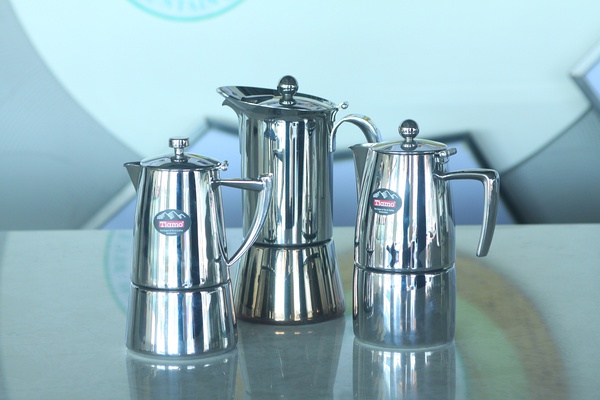
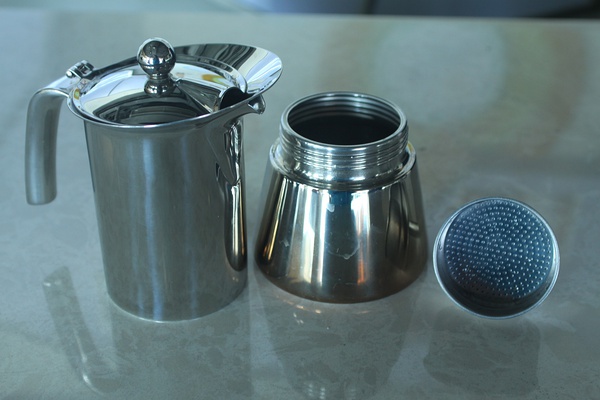
The mocha pot is divided into three parts: the upper seat, the powder trough, and the lower seat. The lower seat is a sink for holding water, and the powder trough is used to hold finely ground coffee powder. The upper seat is to hold the extracted coffee liquid.
If we first put the lower sink aside, fix the powder trough to the bottom of the upper seat of the mocha kettle by hand. We'll see more clearly how he was extracted.
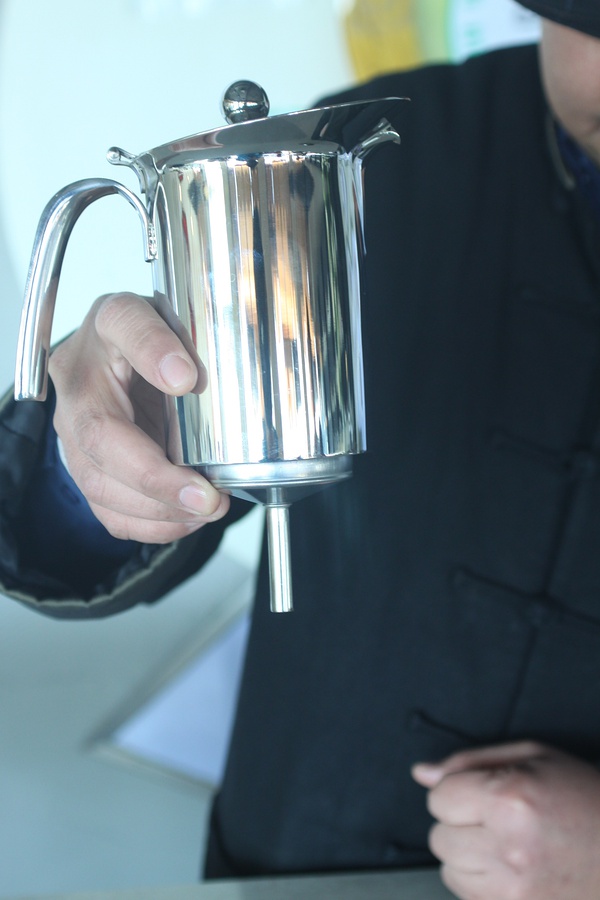
First of all, the metal tube at the end of the powder trough is coaxial and the same diameter as the metal tube in the center of the upper seat, which is designed to make the water flow in a straight line. When the water in the lower seat reaches a certain temperature, driven by pressure, the hot water will be pressed up from the metal tube at the end of the powder trough, through the coffee powder in the powder trough, and then filtered through the filter at the bottom of the upper seat. under pressure, the coffee liquid overflowed from the metal tube in the center of the upper seat. In this way, the process of coffee extraction is finished in principle.
Let's take a look at the lower seat of this metal again.
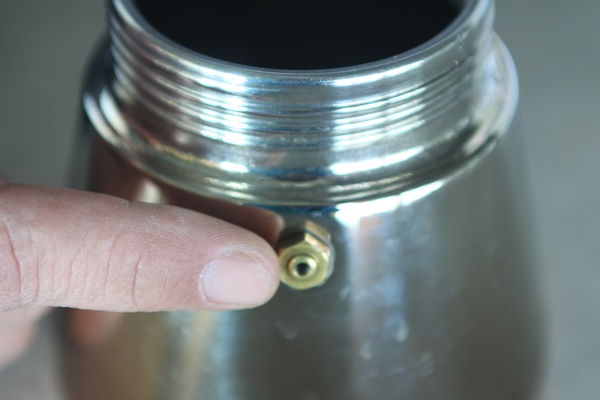
Just from the safety valve above the lower seat, we can conclude that this pot is a container with pressure. When the powder trough is correctly and firmly screwed to the lower seat from the upper seat, it is set on the heat source to be heated, so that the hot water has pressure. So we say that the whole extraction process is completed under pressure. And Espresso, which means "to be under pressure..." in Latin. In other words, the method of boiling coffee with hot water and pressure extraction belongs to Espresso. Espresso is not only the name of this kind of coffee, but also the name of this kind of coffee extraction method.
What kind of coffee is suitable for the mocha pot? Suitable for what kind of grinding fineness:
Let's first take a look at the basic requirement of Espresso Coffee, "want to get the coffee that is closest to the flavor of freshly ground coffee powder". From this alone, we can draw a line of thought on this question.
1) roasted coffee beans
If we need to get strongger (stronger) taste, the process of coffee roasting is the most important. We all know that Dark (deep roasting) is more suitable for making Espresso, the reason is that with the deepening of coffee roasting, the greater the degree of expansion of coffee beans, the easier it is to extract more flavor substances in the later extraction process. But how deep it is depends on the baker's different understanding. Uncle bean will never roast coffee into the second explosion. Because I firmly believe that the coffee after entering the second explosion will not increase the intensity of the flavor, on the contrary, it will reduce the flavor of the coffee and increase the bitter taste of the coffee. "it's never the same thing to have a strong taste and a stronger bitter taste." Today we also see the baking degree of the internationally popular Espresso. There is even a tendency that the baking degree becomes shallow. This can be achieved from baking skills. It's not that if the coffee is lightly roasted, the thickness of the taste will not be enough, at least I don't think so. But for the broad audience, it is appropriate to choose coffee with a deeper roasting degree to make Espresso.
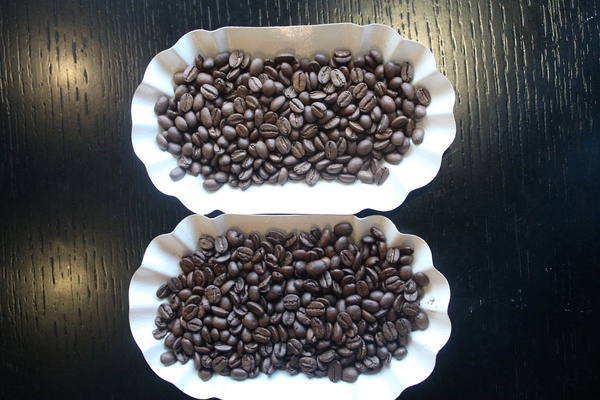
Every roaster is creating an Espresso blend of coffee with their distinctive personal style.
2) Grinding fineness:
Many friends also know that Espresso needs to fine grind the coffee powder in order to get more adequate extraction during the extraction process. Because of coffee.
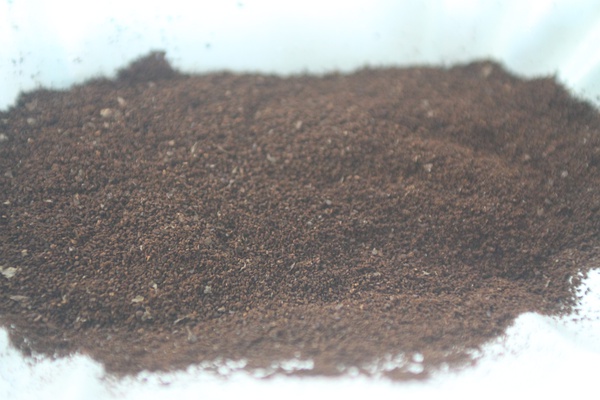
Because the coffee powder is too fine, especially when the powder trough is pressed, the coffee is very difficult to be extracted.
3) Cup quantity:
Many friends who buy a mocha pot will identify how many people it is from the outer box of the mocha pot, such as two, four, eight, and so on. But we should know that the output of Espresso should not exceed that of 60ml at most. After testing a mocha pot for 6 people, the highest water injection in the lower seat is about 400ml. Except for the part of dry coffee powder that absorbs water and the amount of water that cannot be completely pumped, the coffee produced is about less than 300ml, so the amount of coffee per cup is about 45ml. Some friends also asked, why does Espresso need so little cup production? Please take a look at Espresso's request again. Because under the premise of a certain amount of coffee powder, the larger cup of coffee will dilute the taste of coffee. Therefore, we clearly know that in order to achieve people's initial request for Espresso coffee, there should be the following conditions:
a. The deep roasting of coffee (to give it a stronger taste)
b. Fine grinding (increasing extraction rate)
c. A small amount of coffee (to increase the concentration of coffee)
Not only that, under these three conditions, the whole process of coffee extraction is supplemented by steam pressure. This will make the effect of the above three points more magnified.
Third, the production method of mocha pot (statement: the following production method is commonly used by Dou Shu):
1) inject hot water into the lower seat of the mocha pot, and the water level shall not exceed the lower edge of the safety valve. The safety valve is the limit of the maximum water level of each mocha kettle.
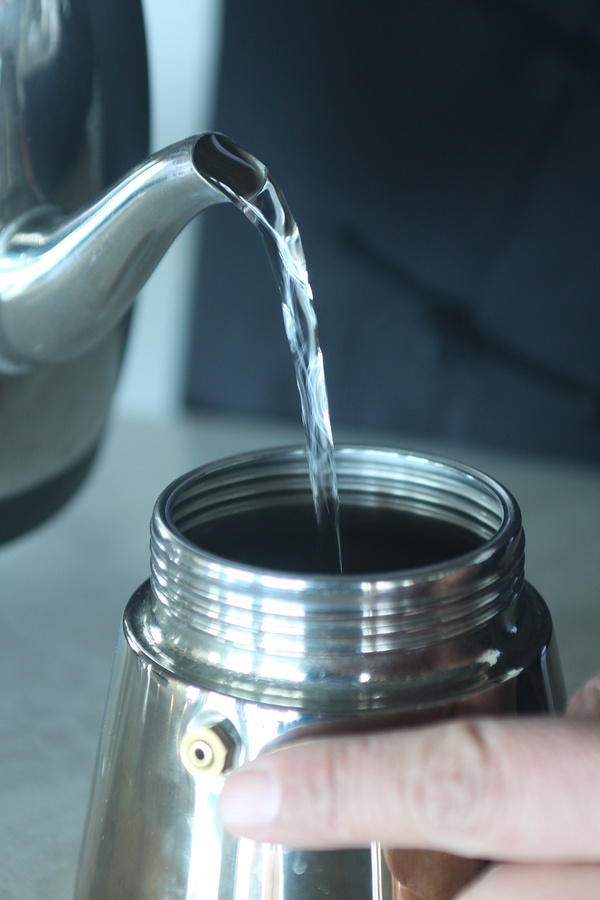
Uncle Dou does not recommend using cold water, which will increase the time it takes to soak coffee powder and make the extracted coffee bitter and turbid.
2) filter paper can be pasted at the bottom of the upper seat.
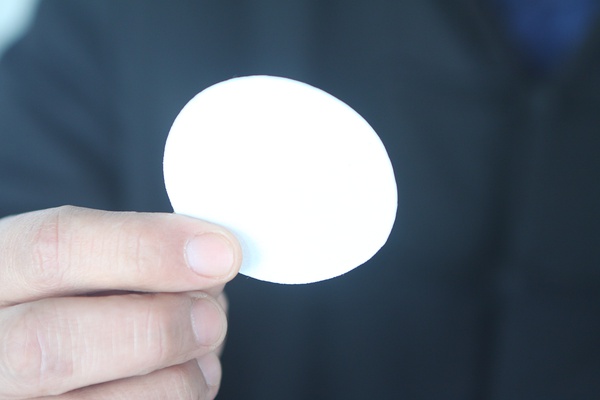
Picture: holding a piece of paper
This is a form of modern mocha pot making method. Ten years ago, the mocha pot was made without filter paper.
When sticking the filter paper, the filter paper should be laid correctly in the middle of the lower seat filter. In order to achieve a better fixing effect, the filter paper can be soaked with water.
3) loading powder. This step is one of the important elements related to the cup effect of coffee (water volume, powder loading, extraction timing). Many friends have made obvious mistakes in this step, which can be summarized as follows:
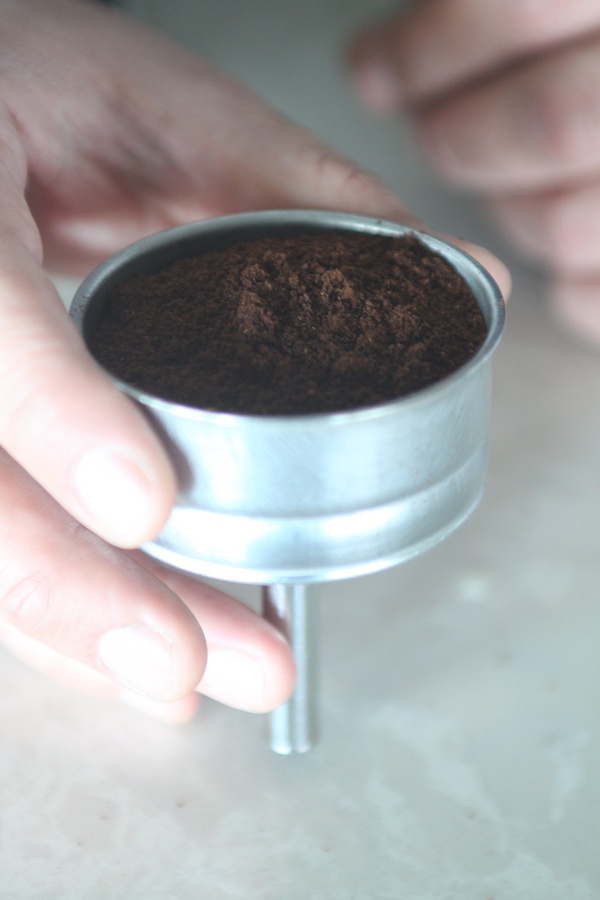
a. There is not enough powder. If you choose the highest water level in the lower seat, your powder should also be fully filled. Otherwise, with the lack of coffee powder, the taste of coffee will gradually fade.
b. Press the powder with a powder hammer. Many friends use the special powder hammer of Italian machine to press the powder trough of Mocha, which is a painstaking move. If the pressure is too tight and the coffee powder is too fine, the coffee will be difficult to draw. So the key to filling a mocha pot with real powder is to fill it as much as possible instead of pressing it tight. The powder can be injected in batches when loading the powder, and the edge of the powder trough can be covered as much as possible without leaving any gap.
When the coffee powder is full, tap the vertical table of the powder trough a few times to ensure that the coffee powder can be fully filled.
Fourth, after correctly placing the powder trough on the lower seat, tighten the upper seat on the lower seat. You can twist it a little too much for safety.
Fifth, heat the correctly installed mocha pot on the heat source. For ease of observation, I suggest boiling the mocha pot with the top open.
Soon the coffee liquid overflowed from the central metal column of the upper seat.
With the continuous extraction, the liquid level of coffee will rise gradually. When there is grease on the liquid surface, please be careful that the coffee extraction is coming to an end. When the color of the oil changes from dark to light, the heat source should be cut off immediately to stop the extraction, otherwise the coffee will be in a state of over-extraction.
In particular, you can't stop after the sound of "snoring". This kind of coffee may even have the taste of roasted rubber.
6. Qualified friends can prepare a towel soaked in cold water in advance and put it next to the heat source. When you finish step 5, put the mocha pot on the cold towel. This will greatly reduce the possibility of over-extraction of coffee.
Tip 2: the maximum service life of the sealing ring under the upper seat of the mocha kettle shall not exceed one year, pay attention to replacement. It's kind of like the rubber seal of a pressure cooker. If it is not replaced in time, there will be lax sealing and air leakage.
Tip 3: if the lower seat pressure relief valve is gassed or leaked during the production of the mocha pot, the thin metal sheet in the middle of the pressure relief valve should be replaced in time, otherwise the pressure of the mocha pot will be greatly lost.
Some friends are still strangers to the mocha pot. In fact, you think of the mocha kettle as your family's pressure cooker, and you'll figure it all out.
The article comes from Uncle Dou.
Important Notice :
前街咖啡 FrontStreet Coffee has moved to new addredd:
FrontStreet Coffee Address: 315,Donghua East Road,GuangZhou
Tel:020 38364473
- Prev
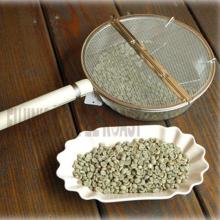
How to bake at home? How to bake coffee beans at home? The skill of baking hand net
Net baking is a home baking developed in Japan and the most widely used method in South Korea. 1. Put the raw coffee beans in the net and heat them on the gas stove. two。 Keep shaking and fishing the net so that the coffee beans are roasted evenly. 3. If the first burst occurs, the shell will begin to splash, and you can blow gently with your mouth or tap the net with a spoon. 4. Proceed to the first
- Next
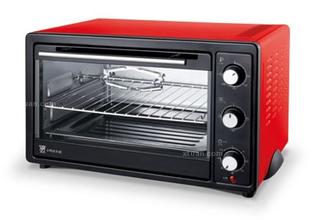
How to bake coffee beans at home in an oven? Home baking skills introduction to oven baking skills
Use the oven to bake 1. Preheat the oven at 270 degrees. two。 Spread all the coffee beans on the baking pan and let each bean touch the baking pan. 3. Always determine the color of the coffee and roast to the desired degree. The total time should not exceed 15 minutes. 4. When showing the desired color, quickly take it out and shake it in the fishing net, take off the shell and cool. Bake in a mini rice pot
Related
- Beginners will see the "Coffee pull flower" guide!
- What is the difference between ice blog purified milk and ordinary milk coffee?
- Why is the Philippines the largest producer of crops in Liberia?
- For coffee extraction, should the fine powder be retained?
- How does extracted espresso fill pressed powder? How much strength does it take to press the powder?
- How to make jasmine cold extract coffee? Is the jasmine + latte good?
- Will this little toy really make the coffee taste better? How does Lily Drip affect coffee extraction?
- Will the action of slapping the filter cup also affect coffee extraction?
- What's the difference between powder-to-water ratio and powder-to-liquid ratio?
- What is the Ethiopian local species? What does it have to do with Heirloom native species?

